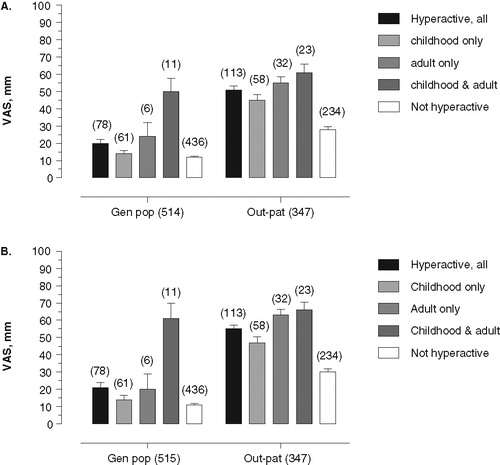Figures & data
Table I. Percentages (%) and number (n) of individuals categorized as Hyperactive (sum of the subgroups Childhood only, Childhood and Adult, Adult only) and Not hyperactive in the general population and out-patient psychiatry samples, respectively. For definitions of groups and subgroups, see Methods.
Table II. Total symptom scores (mean ± SD), Inattention scores and Hyperactivity-Impulsivity (Hyp-Imp) scores in the different groups and subgroups in the general population and the out-patient psychiatry sample. Higher scores indicate higher degree of symptom severity. For definitions of groups and subgroups, see Methods.
Figure 1. Difficulties (A) and Suffering (B) attributed to attention deficit hyperactivity disorder (ADHD)-related symptoms as assessed by the study participants on two separate visual analogue scales (VAS) (see Methods). The numbers of participants in different groups are given within brackets. The differences between Hyperactive versus Not hyperactive groups both for the general population (Gen pop) and the out-patient (Out-pat) samples are statistically significant (P < 0.001 in most cases). The differences are most pronounced for the group with both childhood and adult hyperactivity. The levels of difficulties and suffering in the out-patient sample were significantly higher (P < 0.001) than in the general population both for the Hyperactive and Not hyperactive group except for the subgroups with both childhood and adult symptoms.

Table III. Self-rated general assessment of functioning (GAF) scores (range 1–100, where a score of 1 corresponds to inability to care for oneself, 50 to severe mental problems, and 100 to full mental health) over the past year and past week in the general population and out-patient psychiatry samples and broken down into the different subgroups. For definitions of groups and subgroups, see Methods.
Table IV. Percentages (proportions) with reading and spelling difficulties within the different groups and subgroups in the general population and the out-patient psychiatry samples. For definition of groups and subgroups, see Methods.
Table V. Inattention and hyperactivity-impulsivity scores, difficulties and suffering attributed to attention deficit hyperactivity disorder (ADHD)-related symptoms, global assessment of functioning (GAF), frequency of reading and spelling difficulties, and frequency of conduct (CD) and antisocial personality disorder (ASPD) in the ADHD and the non-ADHD groups (see text).